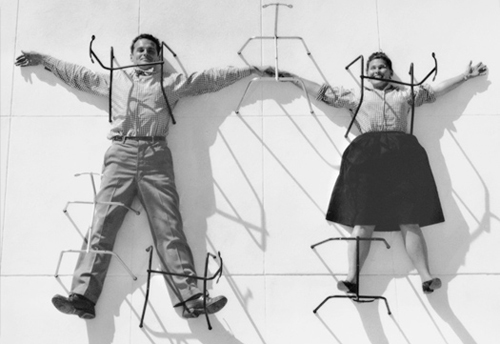Eames: The Architect and the Painter
Though primarily
remembered for their considerable contribution to the fields of
modernist architecture and furniture design, married couple Charles and
Bernice ĎRayí Eames turned their hands to a variety of mediums in their
decades-long personal and creative partnership, including film,
photography, graphic design and fine arts.
So
all-encompassing was their artistic collaboration, in fact, that the two
are rarely referred to as separate entities. They are listed in
Wikipedia and many books on design as ĎCharles and Ray Eames,í and in
the present day, as in their own heyday of the 1950s and 60s, usually
referred to as such. This seems somehow entirely appropriate, not due
to any airy-fairy Ďsingle soul dwelling in two bodiesí hokum but because
the two so thoroughly complimented each other in almost every sense, be
it personal, creative or financial.

As the title
suggests, Charles Eames started his working life as an architect, though
his real passion (bordering on obsession) was furniture design. His
pioneering moulded plywood designs were both simple and stylish, earning
him both a lucrative living and a place in the Pantheon of great 20th
century designers. Owing both to the sexual mores of the day and her
own reticent personality consumers and fellow designers were slow to
appreciate the contribution of Eamesí wife Ray, who in addition to being
a designer was also an accomplished artist, though as the present film
makes clear this visionary and brilliant woman has since been accorded
her due share of recognition.
Eames
isnít quite as immediate or as affecting
as some of the other entries released under Madmanís Arthouse imprint,
such as Herb and Dorothy or William S. Burroughs: A Man Within.
The characterisations drawn arenít perhaps as well-rounded as they could
be and we donít truly feel we know Charles and Ray Eames at the
end of the film. Viewers are repeatedly told of the charisma and
magnetism of Charles in particular, but are given all too few glimpses
of it. Fascinating snippets of the Eames philosophy are projected with
little further discussion, and there is too much emphasis on interviews
with employees and coevals and not enough time on-screen footage of the
couple in action. Donít get me wrong - Eames is still an
accomplished and painstakingly crafted exploration of the lives of these
two pioneering artists. Itís truly very good. But it could have been
brilliant.
Audio &
Video
Iíd never
thought of perpetually stoned actor James Franco as narrator material,
but he has a clear regard for his subjects and actually does quite a
respectable job. The 5.1 audio track is clean and crisp, with a lovely
original score courtesy of composer Michael Bacon and little hiss or
corruption to speak of on even the oldest period footage. The picture
is presented in Madmanís typically blemish-free 16:9 for the most part,
with one or two sections showing some grain due to the age and quality
of the film stock used at the time. All up though it looks and sounds
excellent, and the strong visuals and vibrant colours neatly compliment
the artistry of the Eames worldview.
Bonus
Features
Twelve minutes
of Deleted Scenes, and a smattering of trailers.